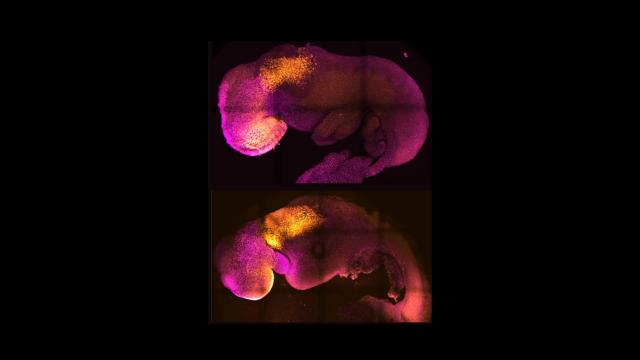Scientists in the UK say they’ve pulled off a feat of genetic engineering: creating a “synthetic” mouse embryo without the need for egg or sperm cells. The embryos were created with stem cells instead and were able to begin developing a brain, heart, and other organs for up to a week. The researchers believe that their work may one day help answer why many pregnancies in humans fail early on in development and could even inform future efforts toward creating lab-grown organs for transplantation.
The study of naturally developed embryos has provided scientists with countless insights about biology. But there are many aspects of early development that aren’t so easy to observe in living creatures. Researchers have learned how to develop already created embryos in the lab to a certain extent, as well as how to produce artificial but simplistic models of embryos or individual organs — advances that have helped overcome some of these hurdles. This new research, however, appears to be one of the first successful attempts to create a functional mouse embryo from scratch.
The work, published Thursday in Nature, is the culmination of years of research by scientists at the University of Cambridge. To create their embryo, they combined the three main types of embryonic stem cells in just the right mix and environment, allowing them to communicate with one another and mimicking what happens naturally during embryonic development. From there, the cells began to arrange themselves into the basic structures of an embryo and started to progress through the early stages of development, including the formation of a yolk sac, brain, and beating heart. The embryos survived for up to eight and a half days.
The team isn’t technically the first to claim the creation of a synthetic mouse embryo. On August 1, scientists in Israel published a paper in Cell detailing their own lab-made embryo. The UK authors noted that their work had been going through the review process for about a year, even before the Israel paper was submitted for publication, and they argue that their model is more complex than anyone else’s to date.
“This is really the first model that allows you to study brain development in the context of the whole developing mouse embryo,” said study author Magdalena Zernicka-Goetz, professor in mammalian development and stem cell biology in Cambridge, at a press conference discussing the findings.
Zernicka-Goetz and her team say that this research should eventually help pinpoint the many reasons why pregnancies can fail early on, even before people are aware of them. Estimates range, but anywhere from 20% to 50% of pregnancies may end in miscarriage, while many embryos created through in-vitro fertilisation can similarly fail to implant to the uterus or otherwise grow. If nothing else, simply being able to study these earliest stages of growth up close could provide scientists with all sorts of information on how we become the way we are.
“It’s an absolutely fantastically complex stage of development, and it has extremely relevant meaning for the rest of our life,” said Zernicka-Goetz.
There are practical health implications that could arise from this research as well, such as the more precise detection of fetal defects early in pregnancy. Their past work has indicated, for instance, that not all embryos diagnosed with defective cells go on to develop health problems, since the embryo can repair itself to an extent. And down the line, what we learn here could even provide lessons on how to create fully functional synthetic organs.
This is all still early days, however, and there are no shortage of ethical questions that will arise from this and similar lines of research. Last year, the International Society for Stem Cell Research relaxed its guidelines for cultivating human embryos in the lab, removing the hard 14-day-limit in place of a case-by-case evaluation. While these guidelines likely don’t apply to simple models of the human embryo, the more complex versions that could one day be created by scientists like Zernicka-Goetz very well might. For their part, the team has been working on and plans to pursue the further development of human synthetic embryos.
Right now, though, the biggest challenge is to create synthetic mouse embryos that can survive past the earliest stages of development in the lab (it takes about 20 days for mice to fully develop). It’s likely that such advancements will require the creation of artificial wombs or placenta-like structures, and scientists are hard at work on that front as well. Last year, the same team from Israel demonstrated that it was possible to grow embryos in a beaker for up to six days, and the Cambridge team says that they’re working on their own approach as well.
